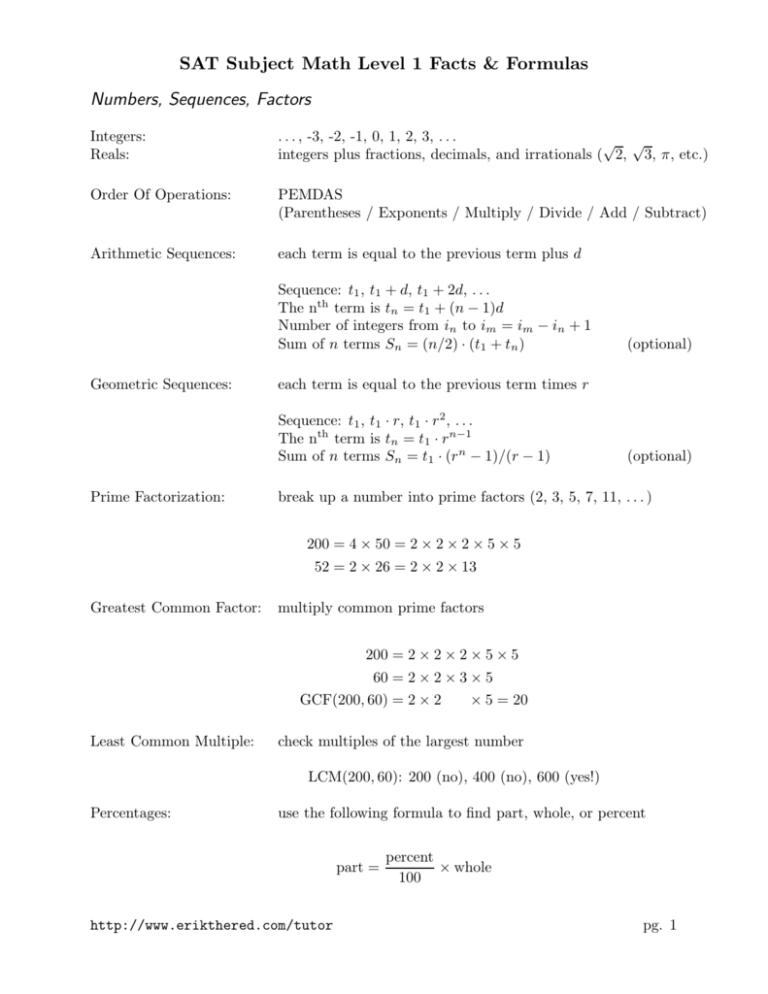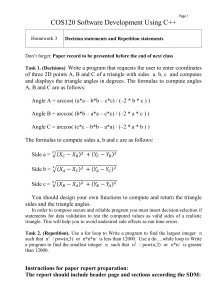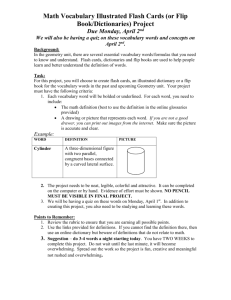SAT Subject Math Level 1 Facts & Formulas
advertisement

SAT Subject Math Level 1 Facts & Formulas
Numbers, Sequences, Factors
Integers:
Reals:
. . . , -3, -2, -1, 0, 1, 2, 3, . . .
√ √
integers plus fractions, decimals, and irrationals ( 2, 3, π, etc.)
Order Of Operations:
PEMDAS
(Parentheses / Exponents / Multiply / Divide / Add / Subtract)
Arithmetic Sequences:
each term is equal to the previous term plus d
Sequence: t1 , t1 + d, t1 + 2d, . . .
The nth term is tn = t1 + (n − 1)d
Number of integers from in to im = im − in + 1
Sum of n terms Sn = (n/2) · (t1 + tn )
Geometric Sequences:
each term is equal to the previous term times r
Sequence: t1 , t1 · r, t1 · r 2 , . . .
The nth term is tn = t1 · r n−1
Sum of n terms Sn = t1 · (r n − 1)/(r − 1)
Prime Factorization:
(optional)
(optional)
break up a number into prime factors (2, 3, 5, 7, 11, . . . )
200 = 4 × 50 = 2 × 2 × 2 × 5 × 5
52 = 2 × 26 = 2 × 2 × 13
Greatest Common Factor:
multiply common prime factors
200 = 2 × 2 × 2 × 5 × 5
60 = 2 × 2 × 3 × 5
GCF(200, 60) = 2 × 2
× 5 = 20
Least Common Multiple:
check multiples of the largest number
LCM(200, 60): 200 (no), 400 (no), 600 (yes!)
Percentages:
use the following formula to find part, whole, or percent
part =
http://www.erikthered.com/tutor
percent
× whole
100
pg. 1
SAT Subject Math Level 1 Facts & Formulas
Averages, Counting, Statistics, Probability
average =
average speed =
sum of terms
number of terms
total distance
total time
sum = average × (number of terms)
mode = value in the list that appears most often
median = middle value in the list (which must be sorted)
Example: median of {3, 10, 9, 27, 50} = 10
Example: median of {3, 9, 10, 27} = (9 + 10)/2 = 9.5
Fundamental Counting Principle:
If an event can happen in N ways, and another, independent event
can happen in M ways, then both events together can happen in
N × M ways. (Extend this for three or more: N1 × N2 × N3 . . . )
Permutations and Combinations:
The number of permutations of n things is n Pn = n!
The number of permutations of n things taken r at a time is n Pr = n!/(n − r)!
The number of combinations of n things taken r at a time is n Cr = n!/ (n − r)! r!
Probability:
probability =
number of desired outcomes
number of total outcomes
The probability of two different events A and B both happening is
P (A and B) = P (A) · P (B), as long as the events are independent
(not mutually exclusive).
If the probability of event A happening is P (A), then the probability of event A not
happening is P (not A) = 1 − P (A).
Logic (Optional):
The statement “event A implies event B” is logically the same as “not event B implies not
event A”. However, “event A implies event B” is not logically the same as “event B implies
http://www.erikthered.com/tutor
pg. 2
SAT Subject Math Level 1 Facts & Formulas
event A”. To see this, try an example, such as A = {it rains} and B = {the road is wet}.
If it rains, then the road gets wet (A ⇒ B); alternatively, if the road is not wet, it didn’t
rain (not B ⇒ not A). However, if the road is wet, it didn’t necessarily rain (B 6⇒ A).
Powers, Exponents, Roots
xa · xb = xa+b
(xa )b = xa·b
0
x =1
xa /xb = xa−b
(xy)a = xa · y a
√ √
√
xy = x · y
1/xb = x−b
+1,
n
(−1) =
−1,
If 0 < x < 1, then 0 < x3 < x2 < x <
if n is even;
if n is odd.
√
√
x < 3 x < 1.
Factoring, Solving
(x + a)(x + b) = x2 + (b + a)x + ab
a2 − b2 = (a + b)(a − b)
“FOIL”
“Difference Of Squares”
a2 + 2ab + b2 = (a + b)(a + b)
a2 − 2ab + b2 = (a − b)(a − b)
x2 + (b + a)x + ab = (x + a)(x + b)
“Reverse FOIL”
You can use Reverse FOIL to factor a polynomial by thinking about two numbers a and b
which add to the number in front of the x, and which multiply to give the constant. For
example, to factor x2 + 5x + 6, the numbers add to 5 and multiply to 6, i.e., a = 2 and
b = 3, so that x2 + 5x + 6 = (x + 2)(x + 3).
To solve a quadratic such as x2 +bx+c = 0, first factor the left side to get (x+a)(x+b) = 0,
then set each part in parentheses equal to zero. E.g., x2 + 4x + 3 = (x + 3)(x + 1) = 0 so
that x = −3 or x = −1.
The solution to the quadratic equation ax2 + bx + c = 0 can always be found (if it exists)
using the quadratic formula:
√
−b ± b2 − 4ac
.
x=
2a
Note that if b2 − 4ac < 0, then there is no solution to the equation. If b2 − 4ac = 0, there
is exactly one solution, namely, x = −b/2a. If b2 − 4ac > 0, there are two solutions to the
equation.
To solve two linear equations in x and y: use the first equation to substitute for a variable
in the second. E.g., suppose x + y = 3 and 4x − y = 2. The first equation gives y = 3 − x,
so the second equation becomes 4x − (3 − x) = 2 ⇒ 5x − 3 = 2 ⇒ x = 1, y = 2.
http://www.erikthered.com/tutor
pg. 3
SAT Subject Math Level 1 Facts & Formulas
Solving two linear equations in x and y is geometrically the same as finding where two lines
intersect. In the example above, the lines intersect at the point (1, 2). Two parallel lines
will have no solution, and two overlapping lines will have an infinite number of solutions.
Functions
A function is a rule to go from one number (x) to another number (y), usually written
y = f (x).
The set of possible values of x is called the domain of f (), and the corresponding set of
possible values of y is called the range of f (). For any given value of x, there can only be
one corresponding value y.
Translations:
The graph of y = f (x − h) + k is the translation of the graph of
y = f (x) by (h, k) units in the plane.
Absolute value:
|x| =
|x| < n
|x| > n
⇒
⇒
+x,
−x,
if x ≥ 0;
if x < 0.
−n < x < n
x < −n or x > n
Parabolas:
A parabola parallel to the y-axis is given by
y = ax2 + bx + c.
If a > 0, the parabola opens up. If a < 0, the parabola opens down. The y-intercept is c,
and the x-coordinate of the vertex is x = −b/2a.
Compound Functions:
A function can be applied directly to the y-value of another function. This is usually
written with one function inside the parentheses of another function. For example:
f (g(x)) means:
g(f (x)) means:
f (x)g(x) means:
apply g to x first, then apply f to the result
apply f to x first, then apply g to the result
apply f to x first, then apply g to x, then multiply the results
For example, if f (x) = 3x − 2 and g(x) = x2 , then f (g(3)) = f (32 ) = f (9) = 3 · 9 − 2 = 25.
http://www.erikthered.com/tutor
pg. 4
SAT Subject Math Level 1 Facts & Formulas
Inverse Functions (Optional):
Since a function f () is a rule to go from one number (x) to another number (y), an inverse
function f −1 () can be defined as a rule to go from the number y back to the number x. In
other words, if y = f (x), then x = f −1 (y).
To get the inverse function, substitute y for f (x), solve for x in terms of y, and substitute
f −1 (y) for x. For example, if f (x) = 2x + 6, then x = (y − 6)/2 so that f −1 (y) = y/2 − 3.
Note that the function f (), given x = 1, returns y = 8, and that f −1 (y), given y = 8,
returns x = 1.
Complex Numbers
A complex number is of the form a + bi where i2 = −1. When multiplying complex
numbers, treat i just like any other variable (letter), except remember to replace powers
of i with −1 or 1 as follows (the pattern repeats after the first four):
i0 = 1
i1 = i
i4 = 1
i5 = i
i2 = −1
i6 = −1
i3 = −i
i7 = −i
For example, using “FOIL” and i2 = −1: (1 + 3i)(5 − 2i) = 5 − 2i + 15i − 6i2 = 11 + 13i.
Lines (Linear Functions)
Consider the line that goes through points A(x1 , y1 ) and B(x2 , y2 ).
Distance from A to B:
Mid-point of the segment AB:
Slope of the line:
p
(x2 − x1 )2 + (y2 − y1 )2
x1 + x 2 y 1 + y 2
,
2
2
y2 − y 1
rise
=
x2 − x 1
run
Point-slope form: given the slope m and a point (x1 , y1 ) on the line, the equation of the
line is (y − y1 ) = m(x − x1 ).
Slope-intercept form: given the slope m and the y-intercept b, then the equation of the
line is y = mx + b.
To find the equation of the line given two points A(x1 , y1 ) and B(x2 , y2 ), calculate the
slope m = (y2 − y1 )/(x2 − x1 ) and use the point-slope form.
Parallel lines have equal slopes. Perpendicular lines (i.e., those that make a 90◦ angle
where they intersect) have negative reciprocal slopes: m1 · m2 = −1.
http://www.erikthered.com/tutor
pg. 5
SAT Subject Math Level 1 Facts & Formulas
a◦
a◦
b◦
b◦
b◦
a
a◦
b◦
◦
b◦
a
l
◦
b◦
a
m
◦
Parallel Lines (l k m)
Intersecting Lines
Intersecting lines: opposite angles are equal. Also, each pair of angles along the same line
add to 180◦ . In the figure above, a + b = 180◦ .
Parallel lines: eight angles are formed when a line crosses two parallel lines. The four big
angles (a) are equal, and the four small angles (b) are equal.
Triangles
Right triangles:
c
60
2x
b
a2 + b 2 = c 2
45◦
x
x
30◦
√
x 3
a
√
x 2
◦
45◦
x
Special Right Triangles
A good example of a right triangle is one with a = 3, b = 4, and c = 5, also called a 3–4–5
right triangle. Note that multiples of these numbers are also right triangles. For example,
if you multiply these numbers by 2, you get a = 6, b = 8, and c = 10 (6–8–10), which is
also a right triangle.
All triangles:
h
b
Area =
http://www.erikthered.com/tutor
1
·b·h
2
pg. 6
SAT Subject Math Level 1 Facts & Formulas
Angles on the inside of any triangle add up to 180◦ .
The length of one side of any triangle is always less than the sum and more than the
difference of the lengths of the other two sides.
An exterior angle of any triangle is equal to the sum of the two remote interior angles.
Other important triangles:
Equilateral:
These triangles have three equal sides, and all three
angles are 60 ◦ .
√
The area of an equilateral triangle is A = (side)2 · 3/4.
Isosceles:
An isosceles triangle has two equal sides. The “base” angles
(the ones opposite the two sides) are equal (see the 45◦ triangle above).
Similar:
Two or more triangles are similar if they have the same shape. The
corresponding angles are equal, and the corresponding sides
are in proportion. For example, the 3–4–5 triangle and the 6–8–10
triangle from before are similar since their sides are in a ratio of 2 to 1.
Trigonometry
Referring to the figure below, there are three important functions which are defined for
angles in a right triangle:
p
hy
opposite
e
s
nu
e
t
o
θ
adjacent
sin θ =
opposite
hypotenuse
cos θ =
“SOH”
adjacent
hypotenuse
“CAH”
tan θ =
opposite
adjacent
“TOA”
(the last line above shows a mnemonic to remember these functions: “SOH-CAH-TOA”)
An important relationship to remember which works for any angle θ is:
sin2 θ + cos2 θ = 1.
For example, if√
θ = 30◦ , then (refer to the Special Right Triangles figure) we have sin 30◦ =
◦
1/2, cos 30 = 3/2, so that sin2 30◦ + cos2 30◦ = 1/4 + 3/4 = 1.
http://www.erikthered.com/tutor
pg. 7
SAT Subject Math Level 1 Facts & Formulas
Circles
Arc
r
n◦
r
(h, k)
Sector
Area = πr 2
Length Of Arc = (n◦ /360◦ ) · 2πr
Circumference = 2πr
Full circle = 360◦
Area Of Sector = (n◦ /360◦ ) · πr 2
Equation of the circle (above left figure):
(x − h)2 + (y − k)2 = r 2 .
Rectangles And Friends
Rectangles and Parallelograms:
l
w
w
h
l
Rectangle
(Square if l = w)
Area = lw
Parallelogram
(Rhombus if l = w)
Area = lh
Trapezoids:
base2
h
base1
Area of trapezoid =
base1 + base2
2
·h
Polygons:
Regular polygons are n-sided figures with all sides equal and all angles equal.
The sum of the inside angles of an n-sided regular polygon is (n − 2) · 180◦ .
The sum of the outside angles of an n-sided regular polygon is always 360◦ .
http://www.erikthered.com/tutor
pg. 8
SAT Subject Math Level 1 Facts & Formulas
Solids
The following five formulas for cones, spheres, and pyramids are given in the beginning of
the test booklet, so you don’t have to memorize them, but you should know how to use
them.
1 2
πr h
3
1
Lateral area of cone with base circumference c and slant height l: S = cl
2
4 3
Volume of sphere with radius r: V = πr
3
Surface Area of sphere with radius r: S = 4πr 2
1
Volume of pyramid with base area B and height h: V = Bh
3
Volume of right circular cone with radius r and height h:
V =
You should know the volume formulas for the solids below. The area of the rectangular
solid is just the sum of the areas of its faces. The area of the cylinder is the area of the
circles on top and bottom (2πr 2 ) plus the area of the sides (2πrh).
r
h
d
h
w
l
Rectangular Solid
Volume = lwh
Area = 2(lw + wh + lh)
Right Cylinder
Volume = πr 2 h
Area = 2πr(r + h)
The distance between opposite corners of a rectangular solid is: d =
√
l 2 + w 2 + h2 .
The volume of a uniform solid is: V = (base area) · height.
http://www.erikthered.com/tutor
pg. 9






